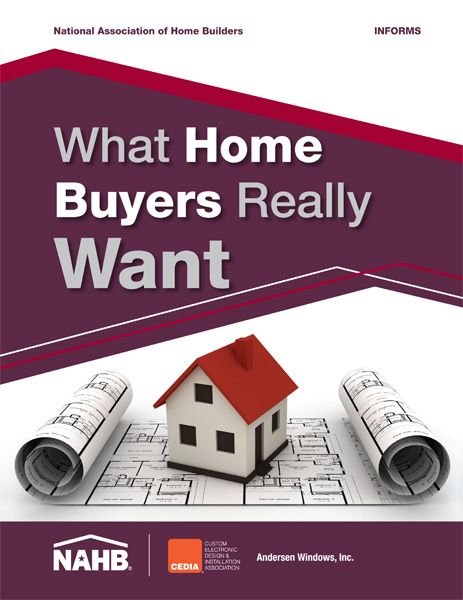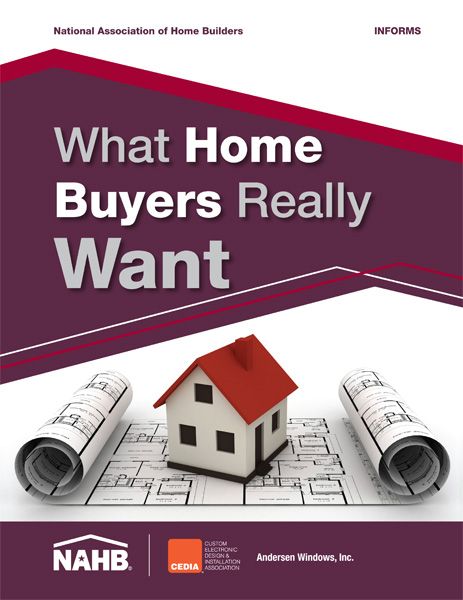
A National Association of Home Builders survey dives deeply into the psyche of American homebuyers, and their preferences may surprise you
American homebuyers care deeply about laundry rooms, basements, brand-name kitchen appliances, having a tub in the master bath, and garage storage. But offer them an elevator, or a lot in a golf-course community, and you’ll get nothing but yawns.
Those and many other preferences on topics both obvious and obscure are contained in What Home Buyers Really Want, a 234-page report by the Economics and Housing Policy Group of the National Association of Home Builders. The report has just been published by NAHB’s publishing arm, BuilderBooks ($50 for members; $150 for non-members).
It’s based on a 2012 online survey of 3,682 respondents, some who had bought a home in the previous three years and others planning on a purchase within three years.
The report offers an executive summary that’s interesting enough on its own (25 percent of buyers don’t care how big their lot is, for instance, while 60 percent are seriously interested in nearby jogging trails). But the real meat is in the details. Subsequent chapters cover house size and style, doors and windows, room layout and design, specialty rooms and energy efficiency. Some results are further broken down by age, income, ethnicity and geography.
Some of the results are to be expected, as in rich people want bigger garages and bathrooms. But some of the nuggets are unexpected: The more times you trade up to another house, for instance, the more willing you are not to have a living room. If you’re a spec builder, the report will make for very good reading.
Here’s a look at some of the topics covered in the report:
The single-family home is still king
By far the largest proportion of people (71%) currently live in a single-family detached house and wouldn’t want it any different were they to buy another house. Those living in townhouses and single-family attached homes (10% of the total) also are likely to buy the same type of home. Residents of multi-family apartment buildings, on the other hand, seem eager to get something else, as do mobile home occupants.
When age is taken into account, younger buyers seem ready to move into single-family while older people would be more willing to look for another type of housing.
As to house size, the largest single group (25%) want a house between 2,000 and 2,499 sq. ft. As buyers get older, the less space they want.
Old or new, and how much
Overall, nearly half (45%) say their first preference would be for an existing home, up sharply from surveys conducted in 2004 (29%) and in 2007 (37%). The rest of the group is about evenly divided between those who would buy a new home offered by a builder and those who want a custom home built on a lot they owned.
But income has an impact. As wealth rises, so does the expectation for a new house.
The single biggest block of respondents (29%) expect to pay from $150,000 to $250,000 for a new house. Only 15% think they’d buy one for less than $100,000. In states fronting the Pacific (California, Washington, Oregon, Hawaii and Alaska) 20% of respondents expect to pay $500,000 or more for a home. That drops to less than 1% for parts of the Deep South.
Tear down the walls
Nearly three-quarters of respondents want the kitchen-family room either completely open or visually open with only a half-wall separating the two spaces. Hardly anyone (just 6%) wants a big kitchen and no family room, and a scant 7% say they want a separate kitchen and family room.
As the cost of the house goes up, so does the expectation that the kitchen-family room will be one big space: 47% of buyers spending $500,000 or more vs. 32% spending $150,000 or less.
In the East, we love our basements
Builders pushing basements will hit it rich in New England, where 87% of homebuyers want one. The upper Midwest and Middle Atlantic regions reported similar results. But further west, interest declines. Only 49% of Pacific region buyers want a basement, and even fewer (46%) in western Gulf Coast states think a basement is important.
Other house layout preferences:
- The wealthier the family, the more bathrooms are expected.
- More than half (57%) of all respondents say they prefer a single-story house, but for those 55 and older that approaches 70%.
- A total of 70% want the washer and dryer located on the first floor (14% said they want the washer/dryer in the basement).
- The more money you have, the bigger the garage you think you’ll need. Nearly half (49%) of buyers paying $500,000 or more for a house expect a garage big enough for three or more cars. For buyers spending less than $150,000, that drops to 9%.
- Brick is still the most popular exterior cladding (34%), with vinyl coming in at 21%. Wood siding continues to fade: it interests just 7% of respondents. But regional variations are significant. (Hint: Brick is huge in the South.)
Energy efficiency and the environment
Energy efficiency, insulation and the impact of construction on the environment have gotten a lot of attention in recent years. Are buyers responding? Well, sort of.
Buying a better insulated home is important to 47% of those expecting to pay $150,000 or less for a home. That drops to only 16% of those planning to spend $500,000 or more.
Buyers spending the most for houses are the most interested in more technology, however, and just about everyone thinks high quality cabinets are important.
Energy Star-rated appliances are the most-wanted feature of 94% of respondents. An Energy Star rating for the whole house (91%) and Energy Star windows (89%) aren’t far behind. A total of 81% want more insulation than required by code.
Most buyers (89%) would be willing to spend between 2% and 3% more for a house with energy efficient features that would lower utility bills. Only 10% would pay $15,000 or more extra to save $1,000 per year in utility costs.
When it comes to concern about the impact of their homes on the environment, 38% say they want an environmentally friendly house but only if it doesn’t cost them any more. Only 14% are willing to pay for it. Also, buyers seem less concerned about the impact of their home on the environment than they were in either of two earlier studies. In 2012, 18% said they were not concerned about the environment, vs. 13% in 2007 and 10% in 2004.
What people really don’t like
As interesting as what people said they wanted in a house is what they dislike. Here’s a short list of items spec builders might want to think twice about offering:
- Elevator (70% don’t want).
- Living in a golf course community (66%).
- Shower only in master bath (51%).
- Wine coolers (42%) and wet bars (41%).
- Pocket doors (26%).
- Wood-burning fireplaces (24%).
- Exposed beams (23%).
Fine Homebuilding Recommended Products
Fine Homebuilding receives a commission for items purchased through links on this site, including Amazon Associates and other affiliate advertising programs.

Handy Heat Gun

Reliable Crimp Connectors

Affordable IR Camera

























View Comments
We want more long-term thinking, design and construction. Energy efficiency that is site-appropriate, i.e., west vs. east coast. Always include a HERS Index for comparison. It is not what the house costs, but what is the operating cost?! "Doesn't cost them any more" - on what time scale? Daily, weekly, monthly, yearly, per decade. We should be emphasizing conservation and efficiency for the long term, not just the sale.